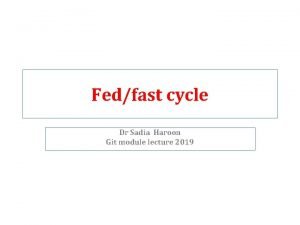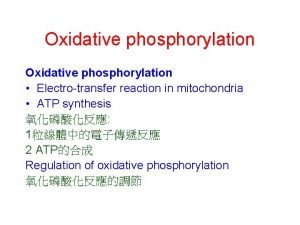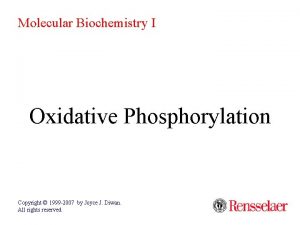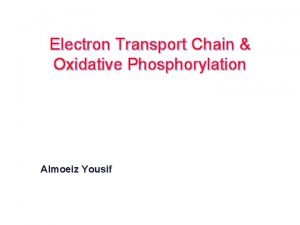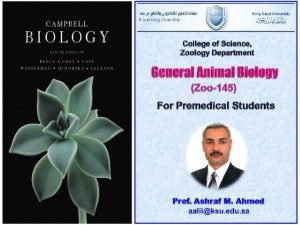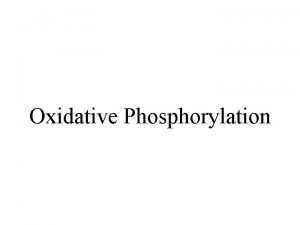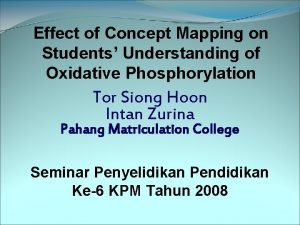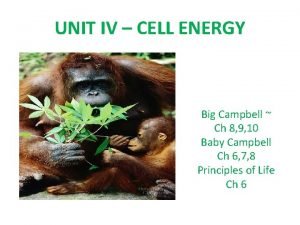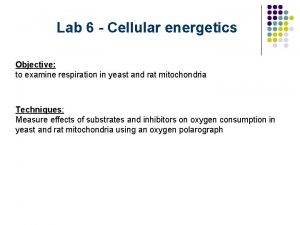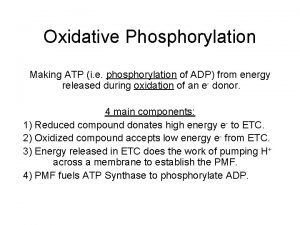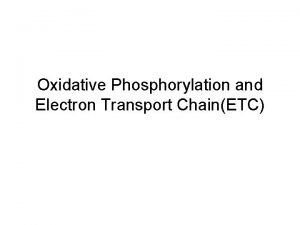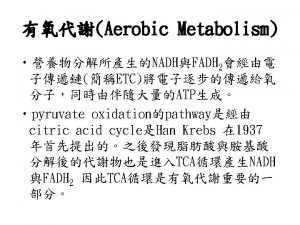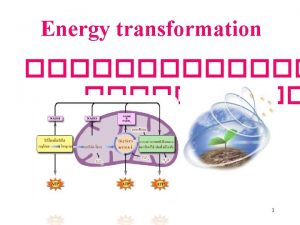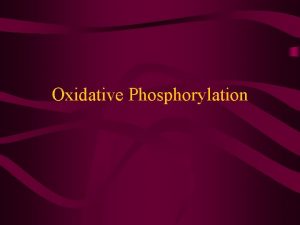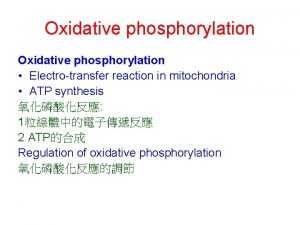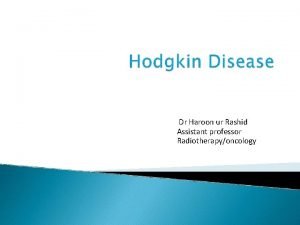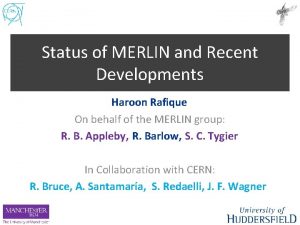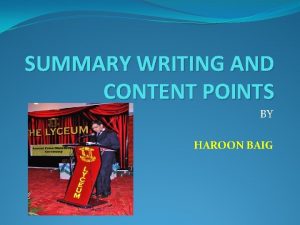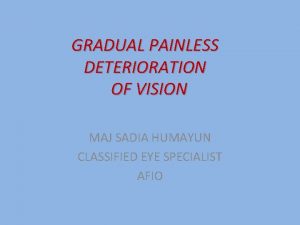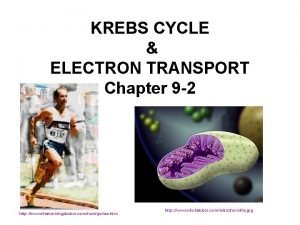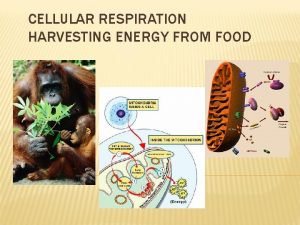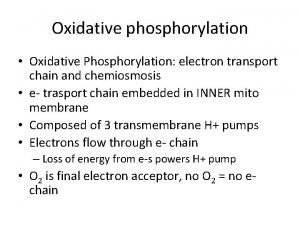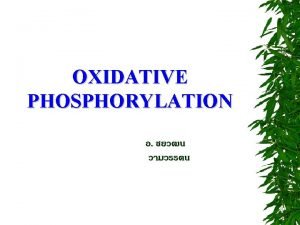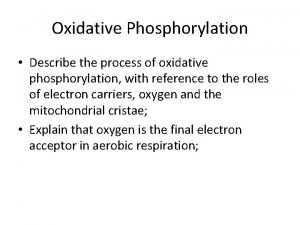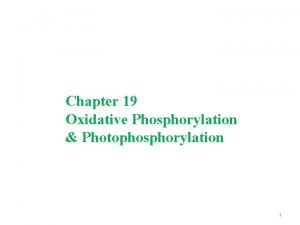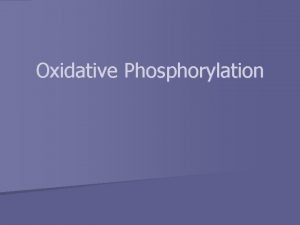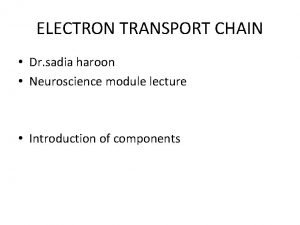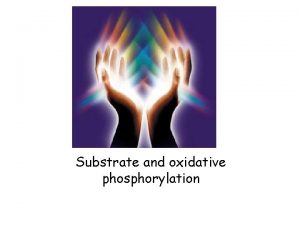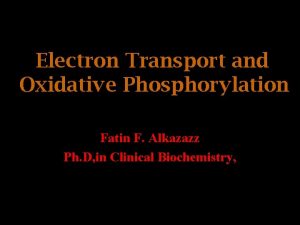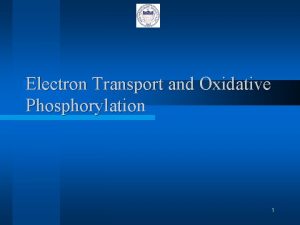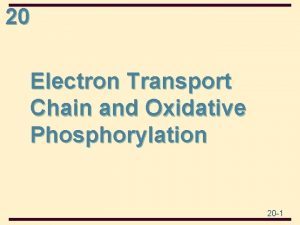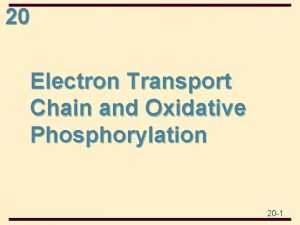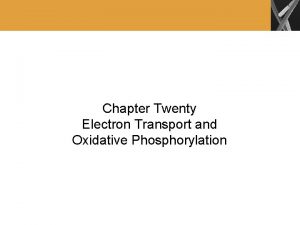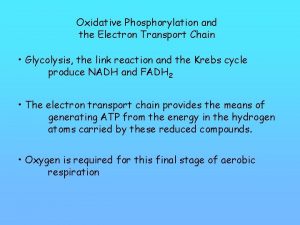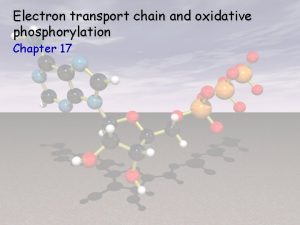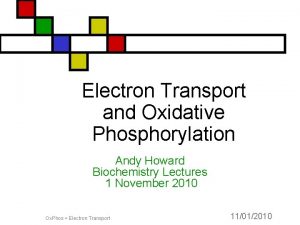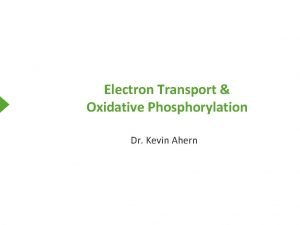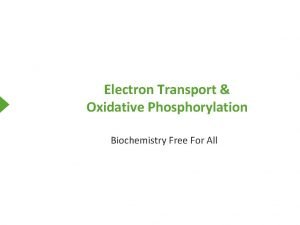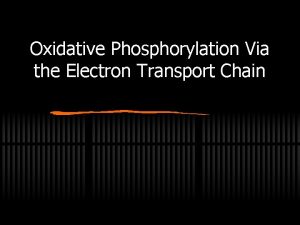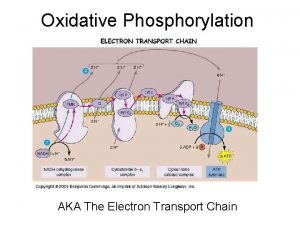Electron Transport and Oxidative Phosphorylation Dr sadia haroon



























- Slides: 27

Electron Transport and Oxidative Phosphorylation Dr. sadia haroon Department of biochemistry Peshawar medical college.

Mitochondria • outer membrane relatively permeable • inner membrane permeable only to those things with specific transporters – Impermeable to NADH and FADH 2 – Permeable to pyruvate • Compartmentalization – Kreb's and β-oxidation in matrix – Glycolysis in cytosol

Most energy from Redox • electrons during metabolic reactions sent to NAD and FAD – Glycolysis • In cytosol • produces 2 NADH – Pyruvate dehydrogenase reaction • In mitochondrial matrix • 2 NADH / glucose – Krebs • In mitochondrial matrix • 6 NADH and 2 FADH 2 / glucose

Electron Transport Chain • Groups of redox proteins – On inner mitochondrial membrane – Binding sites for NADH and FADH 2 • • On matrix side of membrane Electrons transferred to redox proteins NADH reoxidized to NAD+ FADH 2 reoxidized to FAD

4 Complexes • • proteins in specific order Transfers 2 electrons in specific order – Proteins localized in complexes • • Embedded in membrane Ease of electron transfer – Electrons ultimately reduce oxygen to water • 2 H+ + 2 e- + ½ O 2 -- H 2 O

Electron Transport Chain

Complex 1 • Has NADH binding site – NADH reductase activity • NADH - NAD+ – NADH ---> FMN--->Fe. S---> ubiquinone – ubiquinone ---> ubiquinone H 2 – 4 H+ pumped/NADH

Electron Transport Chain

Complex II • succinate ---FAD—ubiquinone – Contains coenzyme Q – FADH 2 binding site • • FAD reductase activity FADH 2 -- FAD

Electron Transport Chain

Complex III • • • ubiquinone - ubiquinone ox while cyt C gets reduced Also contains cytochromes b – proton pump 4 H+ • Adds to gradient – 8 H+ / NADH – 4 H+ / FADH 2

Electron Transport Chain

Complex IV • • reduction of oxygen cytochrome oxidase cyt a+a 3 red ---> oxidized state oxygen ---> water – 2 H+ + 2 e- + ½ O 2 -- 2 H 2 O – transfers e- one at a time to oxygen • Pumps 2 H+ out – Total of 10 H+ / NADH – Total of 6 H+ / FADH 2

Totals • Proton gradient created as electrons transferred to oxygen forming water – 10 H+ / NADH – 6 H+ / FADH 2

Electron Transport Chain

Generation of ATP • Proton dependant ATP synthetase – Uses proton gradient to make ATP – Protons pumped through channel on enzyme • From intermembrane space into matrix • ~4 H+ / ATP – Called chemiosmotic theory

Totals NADH 10 H+ X 1 ATP = 2. 5 ATP 4 H+ FADH 2 6 H+ X 1 ATP = 1. 5 ATP 4 H+

Total ATP from mitochondrial matrix • Pyruvate dehydrogenase – NADH ………………. 2. 5 ATP • Krebs – 3 NADH X 2. 5 ATP/NADH ………. 7. 5 ATP – FADH 2 X 1. 5 ATP / FADH 2………. 1. 5 ATP – GTP X 1 ATP / GTP ……………. . 1. 0 ATP (from a separate reaction) Total ……………. 12. 5 ATP (Per glucose = X 2 = 25 ATP)

What about NADH from glycolysis? • NADH made in cytosol • Can’t get into matrix of mitochondrion • 2 mechanisms – In muscle and brain • Glycerol phosphate shuttle – In liver and heart • Malate / aspartate shuttle

Glycerol Phosphate shuttle • http: //courses. cm. utexas. edu/jrobertus/ch 339 k/overheads-3/ch 19_glycerol-shuttle. jpg

Glycerol phosphate shuttle • In muscle and brain • Each NADH converted to FADH 2 inside mitochondrion – FADH 2 enters later in the electron transport chain – Produces 1. 5 ATP

Total ATP per glucose in muscle and brain • Gycerol phosphate shuttle – 2 NADH per glucose - 2 FADH 2 – 2 FADH 2 X 1. 5 ATP / FADH 2………. 3. 0 ATP – 2 ATP in glycoysis………… 2. 0 ATP – From pyruvate and Krebs • 12. 5 ATP X 2 per glucose ……………. . 25. 0 ATP Total = 30. 0 ATP/ glucose

Malate – Aspartate Shuttle • http: //courses. cm. utexas. edu/emarcotte/ch 339 k/fall 2005/Lecture-Ch 19 -2/Slide 14. JPG

Malate – Aspartate Shuttle in cytosol • In liver and heart • NADH oxidized while reducing oxaloacetate to malate – Malated dehydrogenase • Malate crosses membrane

Malate – Aspartate Shuttle in matrix • Malate reoxidized to oxaloacetate – Malate dehydrogenase – NAD+ reduced to NADH • NADH via electron transport yields 2. 5 ATP

Total ATP per glucose in liver and heart • Malate – Aspartate Shuttle – 2 NADH per glucose - 2 NADH – 2 NADH X 2. 5 ATP / NADH………… 5. 0 ATP – 2 ATP from glycolysis………………. . 2. 0 ATP – From pyruvate and Krebs • 12. 5 ATP X 2 per glucose ……………. . 25. 0 ATP Total = 32. 0 ATP/ glucose

Summary • Total ATP / glucose – Muscle and brain 30. 0 ATP • Uses glycerol phosphate shuttle – Heart and liver • Uses malate aspartate shuttle 32. 0 ATP
 Fedfast tag
Fedfast tag Uncouple oxidative phosphorylation
Uncouple oxidative phosphorylation Uncouplers of oxidative phosphorylation
Uncouplers of oxidative phosphorylation Electron transport chain complexes
Electron transport chain complexes Substrate level phosphorylation vs oxidative
Substrate level phosphorylation vs oxidative Uncouplers of oxidative phosphorylation
Uncouplers of oxidative phosphorylation Concept map about oxidative phosphorylation
Concept map about oxidative phosphorylation Chapter 9: cellular respiration: harvesting chemical energy
Chapter 9: cellular respiration: harvesting chemical energy Oxidative phosphorylation energy yield
Oxidative phosphorylation energy yield Substrate level phosphorylation
Substrate level phosphorylation Azide electron transport chain
Azide electron transport chain Inhibitor of oxidative phosphorylation
Inhibitor of oxidative phosphorylation Inhibitors of oxidative phosphorylation
Inhibitors of oxidative phosphorylation Uncouplers of oxidative phosphorylation
Uncouplers of oxidative phosphorylation Oxidative phosphorylation
Oxidative phosphorylation Define oxidative phosphorylation
Define oxidative phosphorylation Atp synthesis
Atp synthesis Dr haroon ur rashid
Dr haroon ur rashid Haroon rafique
Haroon rafique Content point
Content point Salaina
Salaina Sadia khurshid
Sadia khurshid Sadia humayun
Sadia humayun Dr sadia saad
Dr sadia saad Sadia life
Sadia life Sadia life
Sadia life كريبس سايكل
كريبس سايكل Citric acid cycle and electron transport chain
Citric acid cycle and electron transport chain
